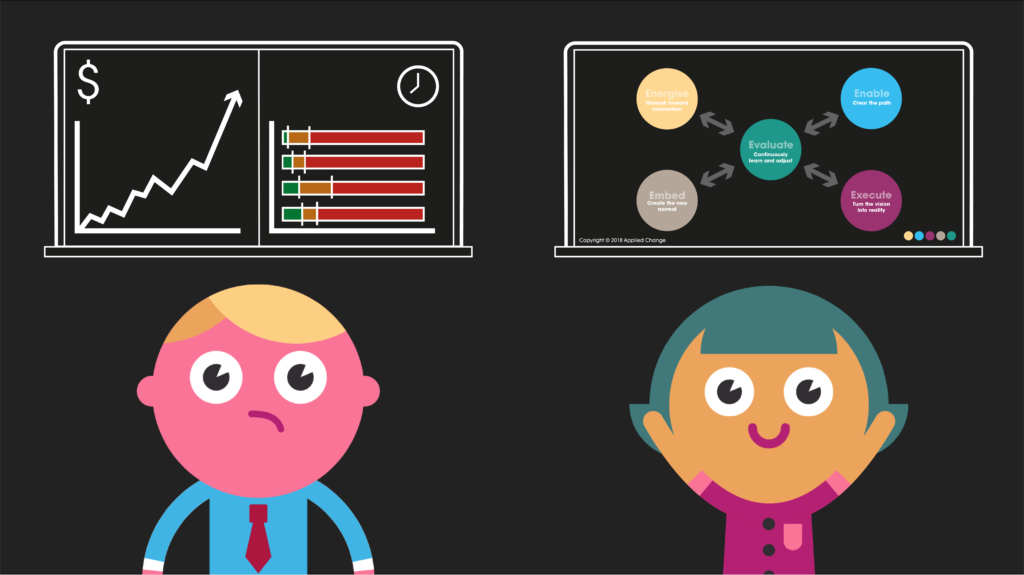Organisational Change – Why do we always focus on schedule and budget?
By Mark Vincent
Share

Having been involved in one of the fastest changing sectors during a period of major disruption, we became curious about why big organisations struggle so much to adapt quickly, even when their very survival depends on it. In an era of increasingly rapid change, agility is becoming critical for survival. And the news headlines continue to prove that size, longevity or reputation offer no protection against market forces.
There is plenty of best practice advice and supporting evidence showing how humans respond best to change, and yet we see very similar mistakes being made again and again. The typical approach, in large organisations especially, is to focus the majority of attention on schedule and budget, because they are visible and easy to measure. In our experience, these measures are actually the least useful and can serve to undermine the natural ability of humans to do something of value.
So why do smart, well educated people continue to make the same mistakes over and over again? Why are these well acknowledged blind spots on change best practice so prevalent in so many large organisations? They can seem so obvious when pointed out because we are all human and so we already know the answer. Yet we can forget in the moment, focusing instead on the thing we are changing.
Part of the reason might be that the available best practice information is too complex and hard to follow. Another reason could be that the critical factors are invisible and therefore more tricky to measure.
We have been working on addressing both the simplicity and the ease of measurement, by developing a simpler model for change and a way of measuring, for each of the elements, the underlying human factors that we know will lead to success.
Our model focuses on just 5 key elements:

Energise
This is the basic fuel for change. It’s about creating a desire. We all need a good reason to change something, especially if it is important to us. Staying as we are normally, feels more comfortable unless we are dissatisfied, and even then can feel like the safer option. Change involves risk and so the reason to do it needs to be compelling enough for everyone involved or affected to make that risk worth taking.
Enable
With any change there will be forces that slow it down. Examples you may recognise are cultural norms “that will never work here”, organisational concerns such as threats to power bases or complex technology that is perceived as hard to change. Fear of losing something or of failing are other examples. Enabling is about understanding these forces and building strategies to reduce them and minimise their impact. Think of it as reducing the friction so that the change can move forward more freely.
Execute
Even the most well intentioned and energised changes can become chaotic if they are not managed and governed properly. This in turn can lead to confusion and conflict very quickly. The focus here is on clarity of how the journey will be taken, where the change is at any given point in time relative to that journey and what decisions need to be taken and by whom.
Embed
Regardless of the situation, we all need time to adjust to any change and to embed the new behaviours that are required. When the pressure is on, there can be a tendency to revert back to what we are comfortable with. Consideration needs to be given to this, focusing on reinforcing, encouraging and rewarding the new behaviours and making the old ways hard or impossible to revert back to.
Evaluate
In our experience the key to success is continuously watching, listening and learning. Continual evaluation of the other four elements is critical and works best when honest feedback is encouraged, especially when the news isn’t what we want to hear. Situations change all the time, especially where people are concerned so it’s important to keep the radar up and keep an open dialogue.
In our experience, any change that is successful will be performing well on each of these elements. Conversely, with changes that don’t go so well, we can point to at least one of these elements that is either missing or has relatively little attention being paid to it. Don’t take my word for it though, test it for yourself using changes you have been involved in or are in the middle of right now. Which of the elements, if improved, would make the biggest difference to your change?
The key to all this is to take the theory and best practice and make it real and accessible. This is why we’ve developed our easy to use diagnostic, so you can actually measure your change against the well-established success factors and then track progress over time.
Do you have a transformational change going on right now that you are concerned about? Maybe the plans and “RAG” rating look ok but your gut is telling you something different? Our diagnostic digs deeper and is specifically designed to give you greater clarity and certainty on the important factors that are often missed. Then you’ll know whether your instinct is right.
Get in touch using the contact form below to arrange a call and / or a walk-through of how it works.
Get in touch
If you’re starting a change, or already on the journey and need some support, we can help.
Whether it’s coaching or mentoring your leadership team, diagnosing low engagement or leading a change on your behalf, we have a range of options to suit different situations and budgets. Contact us by clicking the button to find out more.
Related content
Why people choose us
Our clients tell us its not just what we do but how we do it that matters to them
The Secret to Reducing Change Resistance and Fatigue in Your Organisation
Facing a blend of change resistance and fatigue, Claire’s story highlights the real-world challenges leaders face in evolving business landscapes. What causes change resistance and change fatigue and how are they linked? Learn practical solutions to reduce them and drive successful change in your organisation.
Elon Musk talks Twitter, Tesla and how his brain works — live at TED2022
In this unedited conversation with head of TED Chris Anderson, Elon Musk — the head of Tesla, SpaceX, Neuralink and The Boring Company — digs into the recent news around his bid to purchase Twitter…
A new game needs new rules
The fixed organisation structures commonly used today were developed over 100 years ago. In our fast paced, highly unpredictable world they are likely to be working against us, slowing down and stifling innovation, just when it’s needed most. Technology advancements and globalisation have changed the game completely and so the organisational rules will also need to change.





